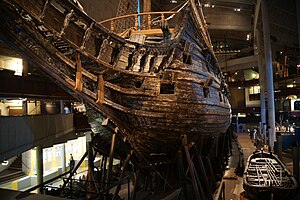 Vasa's port bow
| |
| History | |
|---|---|
| Laid down | 1626 |
| Launched | March 1627 |
| Fate | Sank in 1628, salvaged in 1961, became a museum ship 59°19′40″N 18°05′28″E / 59.32778°N 18.09111°E |
| General characteristics | |
| Tonnage | 1210 tonnes displacement |
| Length |
|
| Beam | 11.7 m (38 ft) |
| Height | 52.5 m (172 ft) from keel to mainmast truck (estimated) |
| Draft | 4.8 m (16 ft) |
| Propulsion | Sails, 1,275 m2 (13,720 sq ft) |
| Crew | 145 sailors, 300 soldiers |
| Armament |
|
| Notes | Source for dimensions & tonnage[1] |
Vasa or Wasa (Swedish pronunciation: [²vɑːsa] ) is a Swedish warship built between 1626 and 1628. The ship sank after sailing roughly 1,300 m (1,400 yd) into her maiden voyage on 10 August 1628. She fell into obscurity after most of her valuable bronze cannons were salvaged in the 17th century, until she was located again in the late 1950s in a busy shipping area in Stockholm harbor. The ship was salvaged with a largely intact hull in 1961. She was housed in a temporary museum called Wasavarvet ("The Vasa Shipyard") until 1988 and then moved permanently to the Vasa Museum in the Royal National City Park in Stockholm. As the most visited museum in Scandinavia, the ship is one of Sweden's most popular tourist attractions and has been seen by over 45 million visitors since 1961.[2][3] Since her recovery, Vasa has become a widely recognized symbol of the Swedish Empire.
The ship was built on the orders of the King of Sweden Gustavus Adolphus as part of the military expansion he initiated in a war with Poland-Lithuania (1621–1629). She was constructed at the navy yard in Stockholm under a contract with private entrepreneurs in 1626–1627 and armed primarily with bronze cannons cast in Stockholm specifically for the ship. Richly decorated as a symbol of the king's ambitions for Sweden and himself, upon completion she was one of the most powerfully armed vessels in the world. However, Vasa was dangerously unstable, with too much weight in the upper structure of the hull. Despite this lack of stability, she was ordered to sea and sank only a few minutes after encountering a wind stronger than a breeze.
The order to sail was the result of a combination of factors. The king, who was leading the army in Poland at the time of her maiden voyage, was impatient to see her take up her station as flagship of the reserve squadron at Älvsnabben in the Stockholm Archipelago. At the same time the king's subordinates lacked the political courage to openly discuss the ship's problems or to have the maiden voyage postponed. An inquiry was organized by the Swedish Privy Council to find those responsible for the disaster, but in the end no one was punished.
During the 1961 recovery, thousands of artifacts and the remains of at least 15 people were found in and around Vasa's hull by marine archaeologists. Among the many items found were clothing, weapons, cannons, tools, coins, cutlery, food, drink and six of the ten sails. The artifacts and the ship herself have provided scholars with invaluable insights into details of naval warfare, shipbuilding techniques and everyday life in early 17th-century Sweden. Today Vasa is the world's best-preserved 17th century ship, answering many questions about the design and operation of ships of this period. The wreck of Vasa continually undergoes monitoring and further research on how to preserve her.[4]
- ^ "Vasa in numbers – The Vasa Museum". 17 October 2015. Archived from the original on 17 October 2015.
- ^ "Welcome to the Vasa Museum". Archived from the original on 1 April 2020. Retrieved 23 April 2020.
- ^ 11 million at Wasavarvet 1961–88 and 18 million at the permanent museum since 1990. The total is based on statistics from the official website of the Vasa Museum: (in Swedish) "Museets besökare" Archived 14 August 2010 at the Wayback Machine, 2011; "Vasas sista färd" Archived 18 August 2010 at the Wayback Machine, 2000(?).
- ^ "The Quest to Find—and Save—the World's Most Famous Shipwreck". Archived from the original on 6 April 2023. Retrieved 8 June 2020.